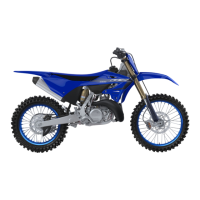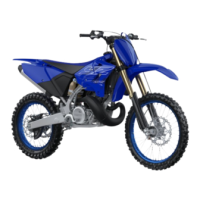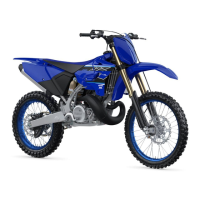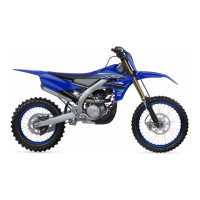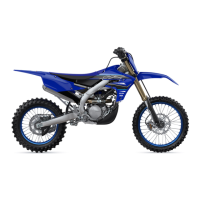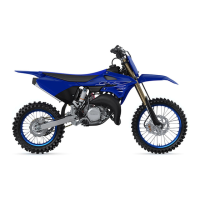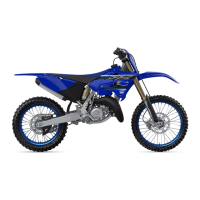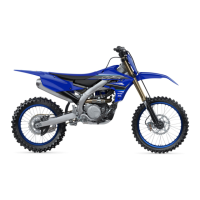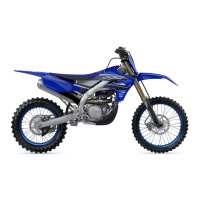Do you have a question about the Yamaha YZ250X 2021 and is the answer not in the manual?
Owner responsibilities, safe riding practices, and protective apparel.
Precautions to avoid carbon monoxide poisoning from engine exhaust.
Mixing fuel and oil, and procedures for starting cold and warm engines.
Recommended break-in procedures for new motorcycles.
Detailed list of engine and chassis components for major maintenance.
Specifications for general fasteners and engine component torques.
Torque specifications for various chassis components.
Proper cleaning methods and precautions to protect the motorcycle.
Warning about contaminants affecting brake performance.
General dimensions, weight, and detailed engine specifications.
Specifications for chassis components and tightening torques.
Engine core specs, fuel, oil, transmission, cooling, and spark plug details.
Specifications related to the clutch mechanism, plates, and springs.
Gear ratios, drivetrain, air filter, and carburetor specifications.
Specifications for chassis, wheels, tires, and brake systems.
Specifications for front fork, springs, oil, and travel.
Specifications for rear suspension, including spring preload and damping.
Torque values for standard fasteners based on nut/bolt size.
Torque specifications for various engine mounting bolts and components.
Additional torque specifications for engine components.
Torque specifications for various chassis components.
Torque specifications for front brake and related chassis parts.
Torque specifications for rear brake and related chassis parts.
Schedule for maintenance and essential pre-operation checks.
Procedures for checking and adjusting engine components.
Table outlining maintenance items and intervals (break-in, race, hours).
Checklist for general inspection before operating the motorcycle.
Procedure for bleeding air from the hydraulic brake system.
Step-by-step guide for replacing front brake pads.
Step-by-step guide for replacing rear brake pads.
Step-by-step guide for assembling the front fork legs.
Procedure for installing the front fork legs onto the motorcycle.
Adjusting rebound and compression damping forces.
Schematic diagram of the motorcycle's electrical wiring.
Common engine problems, causes, and solutions.
Diagnosing and fixing engine starting issues related to no spark.
Diagnosing and fixing engine starting issues related to fuel supply.
Diagnosing and fixing engine problems related to low compression.
Troubleshooting spark plug and fuel supply issues for starting.
Troubleshooting fuel issues affecting mid to high-speed engine performance.
Troubleshooting fuel mixture and carburetor issues for engine performance.
Diagnosing and fixing clutch slippage and dragging problems.
Troubleshooting difficulties with shifting gears and gears jumping out.
Diagnosing and fixing engine overheating and water pump noise.
Diagnosing and fixing poor performance of disc brakes.
Diagnosing and fixing front fork stiffness and softness issues.
Troubleshooting front fork oil leaks.
Diagnosing and fixing rear suspension stiffness problems.
Diagnosing and fixing handlebar wobble and heavy steering.
Diagnosing and fixing front wheel vibration.
Diagnosing and fixing rear wheel vibration.
Carburetor settings, atmospheric conditions, and test runs for engine tuning.
Role of carburetor settings and factors affecting them.
Performing test runs and analyzing spark plug discoloration for tuning.
Troubleshooting carburetor symptoms and adjusting settings.
Tuning for lean mixture symptoms like stalling and poor acceleration.
Tuning for rich mixture symptoms like slow pickup and sooty plugs.
Adjusting front fork settings based on symptoms like stiffness or bottoming out.
Adjusting rear suspension based on symptoms like stiffness or sponginess.
Adjusting rear suspension for symptoms like heavy drag and poor grip.
Owner responsibilities, safe riding practices, and protective apparel.
Precautions to avoid carbon monoxide poisoning from engine exhaust.
Mixing fuel and oil, and procedures for starting cold and warm engines.
Recommended break-in procedures for new motorcycles.
Detailed list of engine and chassis components for major maintenance.
Specifications for general fasteners and engine component torques.
Torque specifications for various chassis components.
Proper cleaning methods and precautions to protect the motorcycle.
Warning about contaminants affecting brake performance.
General dimensions, weight, and detailed engine specifications.
Specifications for chassis components and tightening torques.
Engine core specs, fuel, oil, transmission, cooling, and spark plug details.
Specifications related to the clutch mechanism, plates, and springs.
Gear ratios, drivetrain, air filter, and carburetor specifications.
Specifications for chassis, wheels, tires, and brake systems.
Specifications for front fork, springs, oil, and travel.
Specifications for rear suspension, including spring preload and damping.
Torque values for standard fasteners based on nut/bolt size.
Torque specifications for various engine mounting bolts and components.
Additional torque specifications for engine components.
Torque specifications for various chassis components.
Torque specifications for front brake and related chassis parts.
Torque specifications for rear brake and related chassis parts.
Schedule for maintenance and essential pre-operation checks.
Procedures for checking and adjusting engine components.
Table outlining maintenance items and intervals (break-in, race, hours).
Checklist for general inspection before operating the motorcycle.
Procedure for bleeding air from the hydraulic brake system.
Step-by-step guide for replacing front brake pads.
Step-by-step guide for replacing rear brake pads.
Step-by-step guide for assembling the front fork legs.
Procedure for installing the front fork legs onto the motorcycle.
Adjusting rebound and compression damping forces.
Schematic diagram of the motorcycle's electrical wiring.
Common engine problems, causes, and solutions.
Diagnosing and fixing engine starting issues related to no spark.
Diagnosing and fixing engine starting issues related to fuel supply.
Diagnosing and fixing engine problems related to low compression.
Troubleshooting spark plug and fuel supply issues for starting.
Troubleshooting fuel issues affecting mid to high-speed engine performance.
Troubleshooting fuel mixture and carburetor issues for engine performance.
Diagnosing and fixing clutch slippage and dragging problems.
Troubleshooting difficulties with shifting gears and gears jumping out.
Diagnosing and fixing engine overheating and water pump noise.
Diagnosing and fixing poor performance of disc brakes.
Diagnosing and fixing front fork stiffness and softness issues.
Troubleshooting front fork oil leaks.
Diagnosing and fixing rear suspension stiffness problems.
Diagnosing and fixing handlebar wobble and heavy steering.
Diagnosing and fixing front wheel vibration.
Diagnosing and fixing rear wheel vibration.
Carburetor settings, atmospheric conditions, and test runs for engine tuning.
Role of carburetor settings and factors affecting them.
Performing test runs and analyzing spark plug discoloration for tuning.
Troubleshooting carburetor symptoms and adjusting settings.
Tuning for lean mixture symptoms like stalling and poor acceleration.
Tuning for rich mixture symptoms like slow pickup and sooty plugs.
Adjusting front fork settings based on symptoms like stiffness or bottoming out.
Adjusting rear suspension based on symptoms like stiffness or sponginess.
Adjusting rear suspension for symptoms like heavy drag and poor grip.
| Engine Type | 249cc liquid-cooled 2-stroke; reed-valve inducted |
|---|---|
| Bore x Stroke | 66.4mm x 72.0mm |
| Ignition | CDI |
| Transmission | 5-speed; multiplate wet clutch |
| Final Drive | Chain |
| Suspension Front | KYB® Speed-Sensitive System inverted fork; fully adjustable, 11.8-in travel |
| Suspension Rear | KYB® single shock; fully adjustable, 12.4-in travel |
| Brakes Front | Hydraulic disc, 270mm |
| Brakes Rear | Hydraulic disc, 245mm |
| Seat Height | 38.2 in |
| Wheelbase | 58.5 in |
| Trail | 4.6 in |
| Fuel Capacity | 2.1 gal |
| Wet Weight | 229 lb |
| Tires Front | 80/100-21 |
| Tires Rear | 110/100-18 |
